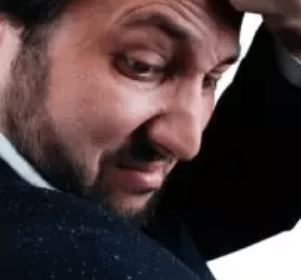Dandruff Test: turn your head upside down and brush or vigorously. Rub your scalp back and forth with fingers over a dark surface over a dark surface.
Scalp test what do you see?
- Tiny, dry powdery bits
- Tiny, dry, powdery bits, you have a dry scalp. That will be a simple fix, increase the moisture in your shampoo. Avoid any anti-dandruff shampoos as it may turn the dry scalp issue into an actual dandruff issue.
- Large moist/greasy flakes
- Flakes are larger and look slightly moist or greasy, they are in fact dandruff. Once you confirm it is dandruff use a professional grade regime (shampoo and treatment), they will contain small amounts of zinc to help remedy the issue.
- Larger greasy flakes and your scalp is irritated and red, and there is a slightly off smell then you may have Seborrhea. It can clear up by itself in some cases. More often, it’s a lifelong issue that clears and flares. It can be controlled with good skincare practices.
- Scales stick to the scalp and it gets itchier and more irritated as you touch it may be Psoriasis (best to consult a dermatologist or Trichologist to treat). Note: when left untreated, it can cause scarring and in some cases hair loss.

Hair Pro Tip:
My rule of thumb is finding your face skin to be drier than normal your scalp is too. It is time to increase the moisture in your shampoo and change the way you condition your hair. Next time you shampoo follow with a conditioner from root to end. Yes, I do say do not apply conditioner to the roots, but when your scalp is dry it means your scalp is thirsty for it. If you are concerned about it weighing down your hair look for a lighter conditioner and do not leave as long. If you have longer hair or dryer ends incorporate a mask to the mid-lengths and ends of the hair.
To learn more about the different types of Dandruff and dry scalp check out these articles:

